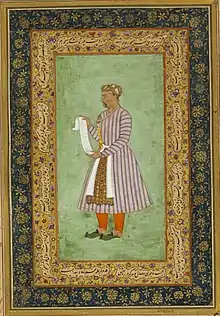Murtaza Khan Shaikh Farid Bukhari | |
|---|---|
 Portrait of Murtaza Khan | |
| Murtaza Khan | |
| Mir Bakhshi of the Mughal Empire | |
| In office 1600–1616 | |
| Monarch | Akbar |
| Monarch | Jahangir |
| Personal details | |
| Born | Sheikh Farid Bukhari |
| Died | 1616 |
| Resting place | Serai Shahji, Delhi |
| Military service | |
| Allegiance | Mughal Empire |
Shaikh Farid Bukhari (died 1616),[1] also known by the title Murtaza Khan, was a leading Mughal noble during the reign of the Mughal emperors Akbar and Jahangir. He served as governor of Gujarat and later of Punjab. He was also well known as an architectural patron in Mughal India, and founded the city of Faridabad in modern-day Haryana, India.
Background
Shaikh Farid Murtaza Khan was an Indian Muslim.[2] His ancestors were likely learned men who had been given rent-free lands for their subsistence. One of them, Sayyid Abdul Ghaffar of Dehli, enjoined his descendants to adopt military profession instead of living on charity. Sheikh Farid's family had a long history of imperial service, such as his uncle Sheikh Muhammad Bukhari, who was one of Akbar's trusted men, and his brother Jafar Khan, who died fighting in Gujarat in 1573.[3]
Career

Shaikh Farid was promoted to the command of 1500 horses by Akbar, for his achievements fighting against Afghans in Orissa. Akbar also bestowed upon him the title sahib-us-saif-w-al-qalam ('master of the sword and the pen').[4] In 1600,[5] he rose to the post of mir bakhshi under Akbar.[6]
In the Mughal court there was a movement of Naqshbandis who had been trying to garner power in the hopes of supplanting the religiously erratic Akbar with a more stable and orthodoxly Muslim emperor. Du Jarric among the Jesuits at court described that Shaykh Farid had been sent as a representative of the orthodox faction to promise support of Prince Salim (future Mughal Emperor Jahangir), "provided that he would swear to defend the law of Mahomet". Shaykh Farid had been receiving letters from Shaykh Ahmad Sirhindi,[7] and was his devoted disciple.[8]
After Jahangir's coronation, prince Khusrau rebelled in 1606 and fled Agra, where he had been confined, towards the Punjab. Shaikh Farid pursued and defeated him at a battle near Bharowal. After Khusrau was later captured, Jahangir awarded Shaikh Farid the title 'Murtaza Khan' for his actions, and his rank was increased to 6000 horses.[4] Jahangir also awarded him the site of the battle, Bharowal, as a land grant.[9]
From 1606 to 1609, Shaikh Farid served as the governor of Gujarat under Jahangir.[10] He later became the governor of Punjab.[1] During this time, Jahangir gave him the infamous order of executing Sikh leader Guru Arjan.[4]
Architecture
Shaikh Farid was noted for his building activities in Mughal texts.[11] A major undertaking was the establishment of Faridabad in 1607, to which he provided a caravanserai and mosque.[12][13] As governor of Gujarat, he constructed extensively in the city of Ahmedabad; however none of these structures remain, with the exception of Wajihuddin's Tomb, the dargah of Sufi saint Wajihuddin Alvi.[10] He also contributed several religious structures to the city of Bihar Sharif, and made additions to the Nizamuddin Dargah in Delhi.[14][12]
Tomb
Shaikh Farid's tomb is located in Malviya Nagar, Delhi, near a caravanserai constructed by him named Serai Shahji.[15]
References
- 1 2 "- Portrait of Shaykh Farid known as Murtaza Khan". www.rct.uk. Retrieved 22 July 2021.
- ↑ Mohammad Akram Lari Azad (1990). Religion and Politics in India During the Seventeenth Century. the University of Michigan.
- ↑ M. Mujeeb (1967). Indian Muslims. McGill-Queen's University Press. ISBN 9780773593503.
- 1 2 3 Singh, Pashaura (28 September 2006), "The Martyrdom Of Guru Arjan", Life and Work of Guru Arjan, Oxford University Press, pp. 205–235, doi:10.1093/acprof:oso/9780195679212.003.0008, ISBN 978-0-19-567921-2, retrieved 22 July 2021
- ↑ M. Mujeeb (1967). The Indian Muslims. McGill-Queen's University Press. ISBN 9780773593503.
- ↑ K., Sharma, Praduman (2000). Mughal architecture of Delhi : a study of mosques and tombs : (1556-1627 A.D.). Sundeep Prakashan. p. 131. ISBN 81-7574-094-9. OCLC 231968849.
{{cite book}}: CS1 maint: multiple names: authors list (link) - ↑ Ellison Banks Findly (1993). Nur Jahan, Empress of Mughal India. Oxford University Press. ISBN 978-0-19-507488-8.
- ↑ Tārana Siṅgha (1981). Sikh Gurus and the Indian Spiritual Thought. Publication Bureau, Punjabi University.
- ↑ Faruqui, Munis D. (2012). The Princes of the Mughal Empire, 1504–1719. Cambridge: Cambridge University Press. p. 229. doi:10.1017/cbo9781139135474. ISBN 978-1-139-13547-4.
- 1 2 Asher, Catherine B. (24 September 1992). Architecture of Mughal India. Cambridge University Press. p. 136. doi:10.1017/chol9780521267281. ISBN 978-0-521-26728-1.
- ↑ Asher, Catherine B. (24 September 1992). Architecture of Mughal India. Cambridge University Press. p. 156. doi:10.1017/chol9780521267281. ISBN 978-0-521-26728-1.
- 1 2 Alfieri, Bianca Maria (2000). Islamic Architecture of the Indian Subcontinent. Lawrence King Publishing. p. 237. ISBN 9781856691895.
- ↑ "Faridabad | India". Encyclopedia Britannica. Retrieved 23 July 2021.
- ↑ Asher, Catherine B. (24 September 1992). Architecture of Mughal India. Cambridge University Press. p. 141. doi:10.1017/chol9780521267281. ISBN 978-0-521-26728-1.
- ↑ "Breaking journey - Indian Express". archive.indianexpress.com. Retrieved 30 July 2021.